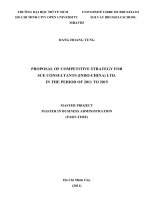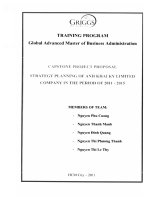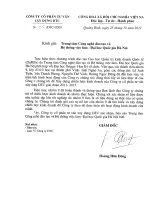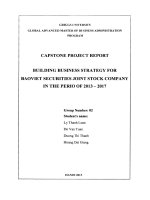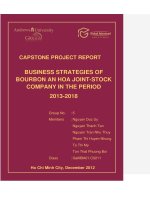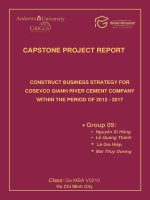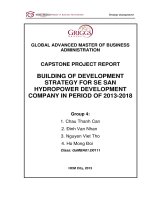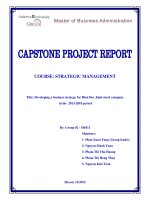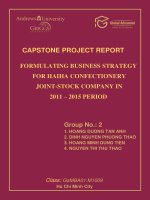Building of development strategy for Se San hydropower development company in the period of 2013-2018
Bạn đang xem bản rút gọn của tài liệu. Xem và tải ngay bản đầy đủ của tài liệu tại đây (1.91 MB, 98 trang )
Strategy management
GLOBAL ADVANCED MASTER OF BUSINESS
ADMINISTRATION
CAPSTONE PROJECT REPORT
BUILDING OF DEVELOPMENT
STRATEGY FOR SE SAN
HYDROPOWER DEVELOPMENT
COMPANY IN PERIOD OF 2013-2018
Group 4:
1. Chau Thanh Can
2. Đinh Van Nhan
3. Nguyen Viet Tho
4. Ho Mong Đoi
Class: GaMBA01.D0111
HCM City, 2013
Strategy management
1
ACKNOWLEDGEMENT
During the time of attending to Training Program on Master of International
Business Administration, all of teachers have enthusiastically taught, imparted
knowledges that are very useful to us and we have applied them to our organization
effectively. We would like to express our sincere gratitude to all of teachers who
guided us to complete this MBA program.
We also thank the Board of Directors, the departments and workshops of Se
San Hydropower Development Company about enthusiasm, enabling for us on
studying, data collection to complete topic.
Finally, we would like to thank the Electricity of Viet Nam, College of
Electric Power Ho Chi Minh City in making the best conditions for us to complete
MBA course.
Our team is pleased to assure that this topic is the study of us. All data and
contents in this topic are found out, studied and built by team of ourselves. All data
collected is completely true.
Strategic management
2
CONTENTS
ACKNOWLEDGEMENT 1
INTRODUCTION 7
1. Why choose the topic. 7
2.The goal of topic. 7
3. The scope of study 8
4. Methodology 8
5. The layout of topic 8
CHAPTER I: THEORETICAL BASIS 9
1.1. The concept of strategy and strategic management 9
1.1.1. Strategy 9
1.1.2. Strategic Management 9
1.2. The views of strategy and strategic management 9
1.3. Building strategy 10
1.3.1. Process building strategy 10
1.3.2. Determination of base for building strategy 11
1.3.3. The targets of strategy 12
1.3.4. Analysis external environment 12
1.3.5. Models of five competitive pressures 14
1.3.6. Analysis of internal environment 17
1.4. Stages of Strategic Management 23
1.5. Points to note in the process of strategic management 24
1.6. The matrix strategic form 26
1.6.1. SWOT Matrix 26
1.6.2 CPM Matrix (Competitive Profile Matrix) 28
1.6.3. IFE Matrix (Internal Factor Evaluating) 29
1.6.4. QSPM matrix (Quantitative Strategic Planning Matrix) 31
1.7. Conclusions of Chapter I 32
Strategic management
3
CHARTER II: 34
ANALYSE THE ACTUAL PRODUCTION AND BUSINESS OF SESAN
HYDROPOWER DEVELOPMENT COMPANY 34
2.1. Establishment and development 34
2.1.1. Historical establishment 34
2.1.2. Organizational structure 35
2.1.3. Funtions, tasks and line of business 36
2.2. Analyze of the producing activity management of the Company 36
2.3. Analyze the value chain of the company 37
2.3.1. The principal activities increase value chain 37
2.3.2. Analyze supporting activities 40
2.4. Analyze of the macro environment 45
2.4.1. Economic environment and demographic environment 45
2.4.2. Science and technology environment 45
2.4.3. The social and cultural environment 45
2.4.4. Political, law environment 46
2.5. Analyze the five competitive pressures of environment 46
2.5.1. The corporates in the industry 46
2.5.2. Products for replacement 47
2.5.3. Pressure from the customers 47
2.5.4. Pressure from the suppliers 48
2.5.5. Pressure from competitors 48
2.6. Survey of the council on the internal resources of the company 50
2.7. Matrix IFE -Matrix EFE 51
2.7.1. Evaluation of the internal factors (Matrix IFE) 51
2.7.2. Assessment of external factors (Matrix EFE) 60
2.8. SWOT matrix 70
2.8.1 Strengths and weaknesses of the internal environment 70
2.8.2. Opportunities and threats of the external environment 71
Strategic management
4
2.9. Competitive Profile Matrix (CPM) 75
2.10. Aspects of corporate culture for the selection and implementation of
strategy 76
2.11. Conclusion of chapter II 76
CHAPTER III 78
DEVELOPMENT STRATEGY OF SESAN HYDROPOWER DEVELOPMENT
COMPANY IN THE PERIOD OF 2013 – 2018 78
3.1. Development strategy of the company in the period of 2013-2018 78
3.1.1. Vision: The Company will be leading in low costs in electricity supply 78
3.1.2. Mission: Continuous power supply with better quality 78
3.1.3. Core values: Trust - Devoted - Wisdom - Collaboration – Share 78
3.1.4. Strategic goals 78
3.2. Building strategies for the company 79
3.2.1. The “leading in low costs” strategy 79
3.2.2. The “advantage in offering in the electricity market” strategy 79
3.3. QSPM matrix (Quantitative Strategic Planning Matrix) 80
3.4. Select strategy for the company 91
3.5. Solutions for strategy implementation 91
3.6. Strategy controlling 94
3.7. Recommendations and conclusions 95
3.7.1. Recommendations 95
3.7.2. Conclusion 95
REFERENCES 97
Strategic management
5
DIRECTORY
I
LIST OF ABBREVIATION
No.
List of abbreviations
Explanation
1
CBCNV
Officials and employees
2
VTTB
Material and equipment
3
EVEN
Vietnam Electricity Group
4
SCTX
Regular repair
5
SCL
Overhaul
II
LIST OF FIGURES, TABLES
No.
Name of figure, charts
Page
Figure 1.1
The process of strategy building
10
Figure 1.2
The relationship and the meaning of the vision, mission and
values
11
Figure 1.3
Three levels of the external environment.
12
Figure 1. 4
Michael Porter's five competitive pressure model
15
Figure 1.5
Effect of five pressures on the attractiveness of the industry
17
Figure 1.6
Michael Porter's value chain.
19
Table 1.1
Evaluation of corporates based on success factors.
23
Figure 1.7
Strategic management is a continuous and regular process.
25
Figure 1.8
The strategic level a multi-industry company
25
Table 1.2
SWOT matrix
27
Table 1.3
CPM matrix
29
Table 1.4
IFE matrix
29
Table 1.5
EFE matrix
30
Table 1.6
QSPM matrix, strategic group S-O
31
Figure 2.1
The value added chain of Se San Hydropower Development
Company
37
Table 2.1
Labor structure by level
41
Table 2.2
Table of labor structure by age of worker
41
Table 2.3
Report production and business activities of 3 years (2010,
2011, 2012) of the Company.
43
Strategic management
6
Table 2.4
Capacity, output, cost and product price (VND/kWh) of the
hydroelectric plants in the sector in 2011
46
Table 2.5
The group investing in the field of energy production from
2013 to 2018
49
Table 2.6
Matrix evaluating inside elements
52
Table 2.7
Evaluation of the company's strategic building council on
how important of the inside elements
53
Table 2.8
Evaluation of the company's strategic building council
on classification (points earned) of inside elements - Matrix
IFE
55
Table 2.9
Matrix assessing factors (Matrix EFE)
61
Table 2.10
Assessment of the members of the company‟s strategic
building council on how important external factors- Matrix
EFE
63
Table 2.11
Assessment of the members of the company‟s strategic
building council on classification (points earned) of external
factors- Matrix EFE
65
Table 2.12
SWOT matrix (combination)
72
Table 3.1
QSPM matrix
81
Table 3.2
Assessment of members of the Strategies Board for
attractive scores of the "Offering in the electricity market"
strategy
85
Table 3.3
Assessment of members of the Strategies Board for
attractive scores of the "Leading in low costs" strategy
88
Table 3.4
Plan the budget of the company from 2013 to 2018
91
Se San 4 Hydropower Plant
Strategic management
7
INTRODUCTION
1. Why choose the topic.
Se San Hydropower Development Company was officially put into operation
on 01/04/2010, with the function of operational management on the Se San 4
Hydropower plant which consists of 03 units at total capacity of 360MW. Annual
electricity output is about 1.4 billion kWh. Se San 4 Hydropower plant was started
upon construction in 11/2004 on Se San River lying on the territory of 02 provinces
of Gia Lai and Kon Tum.
Activities of Se San Hydropower development Company is now steady,
achieve business plans, but possibility and potential of the company are still more.
The question in setting up the development strategy for the company is how to
exploit fully ability, potential of the company in future.
Annual electricity demand is increasing by average of about 12%. The
direction of our research is to build competitive strategies by that how Se San
Hydropower Development Company output power is greater than the other
competitors. We determine the level of strategy for the company is the business
level. We wish this topic is the base to help the leaders of Se San Hydropower
Development Company put out relevant decisions in order to achieve targets most
effectively. That's why we chose this topic.
2.The goal of topic.
The goal of this topic is to analyze and assess the current status of production
and business activities of Se San Hydropower Development Company;
opportunities and threats from the external environment; strengths, weaknesses
from the internal environment of company. From then, the development strategy
suitable for the company is built and the solutions of strategic implementation are
proposed. Name of subject that we study is "Building of development strategy for
Se San Hydropower Development Company in period of 2013-2018".
Strategic management
8
3. The scope of study.
The scope of study is to build a theoretical basis for development strategy of
Se San Hydropower Development Company in period of 2013-2018, in which we
study in depth to promote the advantages of Se San hydropower plant to compete
with other Hydropower plants in the electricity sector.
4. Methodology.
Method of study is date collection from internal of Se San Hydropower
Development Company then analysis and apply the strategic matrixes to build a
development strategy for this company.
The scientific and practical significance of the subject can be used as a value
reference to build business strategy for other businesses with similar characteristics
as Se San Hydropower Development Company.
5. The layout of topic.
In addition to the introduction, conclusion and appendices attached, the
contents of the topic are divided into three main sections as follows:
Chapter I: Theoretical basis
This chapter presents the theory of formulating strategies, application some
matrixes to help strategic choice and issues in strategic management.
Chapter II: Situation Analysis of Se San Hydropower Development
Company.
This chapter introduces an overview of the Se San Hydropower
Development Company, analyze the business situation of the company in the past.
Chapter III: Building of development strategy for Se San Hydropower
Development Company in period of 2013-2018.
This chapter analyzes the inside and outside environmental factors from
which the matrixes as SWOT, IFE-EFE, QSPM to choose development strategy for
this company in period of 2013-2018 are built and proposal solutions for strategy
implementation is issued.
Strategic management
9
CHAPTER I: THEORETICAL BASIS
1.1. The concept of strategy and strategic management.
1.1.1. Strategy:
Strategy is a series of work setting in order to create competitive advantage
of the business compared to other competitors. The strategy represents a unique
value creation, the selection, the rating for in competition. When building business
strategy, we have to determine where the business is , where and how the business
wants to reach.
1.1.2. Strategic Management:
Strategic Management is implementation and evaluatation of the decisions
related to various activities which allow a business to achieve the set-out strategic
goals. Strategic Management focuses on consolidated management of all
operational fields of the business to achieve success.
1.2. The views of strategy and strategic management:
- In Michael Porter's point of view, strategy is creating out an unique position
and valuable including different activities. Strategy is selection, staying or retreating
in competitionbut the importance is to choose what should be done and what shall
be omitted. Strategy is creation of the compatibility from all business's activities.
Competitiveness is obtained from the activities system rather than from its
component parts. Compatibility from the activities occurs when this action
contributes consolidation and strengthening the effectiveness of the other activities
in the value chain of the business. (Source: "What is the strategy", Harvard Business
Review, 1996).
- By Fred David, "Strategic Management is terms of art and science that
establish, implement and evaluate decisions related to various functions which
allow organizations to achieve the set-out goals." (Books: "The concept of strategic
management", Labor Publisher, 2012).
Strategic management
10
1.3. Building strategy:
1.3.1. Process building strategy:
Process building strategy is described as Figure 1.1 below.
Figure 1.1: The process building strategy
Evaluate the
effectiveness
Define vision
and mission
Analysis internal
environment
Identify the
strategic goals
Formation strategies:
- Company level
- Business Level
- Function level
- Operational level
Analysis external
environment
Implement
solutions
Strategic management
11
1.3.2. Determination of base for building strategy:
Vision, mission, values are the foundation of strategy. A business without a
vision will not go to the destination; without mission will not has the goal; without
values will not has the guiding principles of operation.
1.3.2.1. Vision:
When building of strategy, strategic planners must answer the question, "our
business will look like in the future?". So, saying about the vision is saying about
the future scenarios of the business. For example, the vision of the Electricity of
Viet Nam: Leading economic group in the power sector in Vietnam and the region,
keeping a leading role in the task of ensuring national energy security.
1.3.2.2. Mission:
When building strategies, strategic planners must answer the question "Why
do we exist?". The mission of a business shows business exists to do what and do
what to exist. For example, the mission of the Electricity of Viet Nam: Fully meet
power demand for customers with quality and service better and better.
1.3.2.3. Core Values:
When building strategies, strategic planners must answer the question "What
important that we have always done?". These values are the principles have to effort
Figure 1.2: The relationship and the meaning of the vision, mission and values
Vision:
We will be
like in the
future.
Values: What
important that
we have always
done?
Mission:
Why do we
exist?
Strategic management
12
making to bring success to business. For example, the core values of the Electricity
of Viet Nam: Quality - Trust; Devotion - Intellect; Cooperation - Share; Creative -
Efficiency.
1.3.3. The targets of strategy:
The targets of strategy is the destination that business will go to. The targets
of strategy need to ensure specific, quantified and a clear deadline. Target selection
must be consistent with the factors inside and outside of the business. A business
selects high profit, target of strategy is reduce the cost. However, select a mismatch
target of strategywill lead business to the wrong way and unsustainable
development.
1.3.4. Analysis external environment:
The goal of external environment analysis is awarness of opportunities and
threats from external environment that affects to operation of the business.
1.3.4.1. The three levels of the external environment:
The external environment has three levels: the macro environment (including
factors of economy; culture, society; globalization; technology; law, politics;
demography), sector environment and competitive environment. Figure 5 below
shows the three levels of the external environment.
Social and cultural
environment
Global
environment
Technological
environment
Law and political
environment
Demographic
environment
Economic
environment
Figure 1.3: The three levels of the external environment
Competitive
environment
Sectorial environment:
- The threat of new entry
- The power of suppliers
- The power of buyers
- Alternative products
- Intensity of competition
Strategic management
13
1.3.4.2. Macro Environment:
- Economic Environment: The macro economic environment has always
caused impact to the business, can alter the ability to create incomes and value of
the business. Four important factors in the macro economic environment are the
growth rate of the economy, bank interest rate, exchange rate and inflation rate.
These four factors is both of opportunity and challenge for the business
administrators. So, through the information resources, the business must always
monitor, update and analyze macro economic environment to promptly adjust
strategy goals of the business.
- Technological environment: Technological environment both creates
opportunities and threats to the enterprise. It is also the barriers to enter and reshape
the structure of business activities. As digital technology has been strongly
developing, Kodak was too slow in recognizing the threat from the outside, still
conservative in unchanged technology that led Kodak to the verge of bankruptcy.
Whereas, many manufacturers have passed the height of barriers to enter and
succeed such as mobile phones and tablet PCs of Apple, Samsung with superior
technology than any other manufacturer.
- The cultural, social and demographic environment: The changes in
culture, society and demography importantly influence to the products, services and
consumers. For example, talking about the population, migration, average income
per capita, lifestyle, urban environment, Vietnam society in 1980s was so big
different from the one nowaday. These changes create opportunities and
challenges for the businesses in strategy building. Decision where to build a factory
and distribution center, what area to effort marketing products and services poses to
the strategist before changes about cultural, social and demographic environment.
- The political and law environment: Political instability, new policies
issuance are factors that have a major impact on business operations of the
businesses. So, it is required that businesses have to forecast changes of political,
Strategic management
14
law environment, including domestic and international law to identify the
opportunities and threats for building and implementation strategies of business.
- Global environment: Globalization makes the social nature of production
expanding on a global scale. However, international business requires a deep
understanding of the regulations, international laws, trends, market needs, otherwise
the business will be difficult to survive before fierce competition from the other
countries. This is not only the challenge, but also the opportunity for local
businesses looking for new business environment.
1.3.4.3. Sectorial Environment:
Sector is a group of businesses that provide the substitutional products or
services. The goal of competition in a sector can be: price, product quality, product
design, features of the product, customer servicing The attractiveness of sector
derived from goal competition between the businesses in sector in order to maintain
or increase profits. What business now has the most powerful position, who will rise
to replace in the future is a challenge for all enterprises in the sector.
1.3.4.4. Competitive environment:
The competitive environment is a collection of competitive actions of
businesses in the same sector. Competitive environment analysis is the process of
collecting and analyzing all the information about the businesses that we are
competing with them.
1.3.5. Models of five competitive pressures:
Michael Porter put out the model of five competitive pressures , to be
published in the Harvard Business Review in 1979. According to Michael Porter,
five competitive forces in the sector: (1) the intensity of competition between
businesses in the sector; (2) negotiating power of buyers; (3) negotiating power of
suppliers; (4) the threat of new entry; (5) threat of substitute products.
Strategic management
15
1.3.5.1. Analysis of five pressures of competition :
a. Intensity of competition between businesses in a sector: competitive
actions of a business usually bring about reactions from the other businesses. Each
competitor runs in a special type leading to fierce competition. Intensity of
competition may be strong, moderate, or weak, depending on the businesses efforts
how to win competitive advantage. Factors affecting competition between
competitors in the sector include : the number of competitors (including potential
competitors), the state of growth of the sector, the level of concentration of the
sector, the cost of fixed, the difference between the products, the entry barriers to
the sector and retreat from the sector.
b. The negotiating power of buyers (customers): Customers are always
requiring businesses to provide the best products with lowest price. So, the business
always face with pressure from the bargaining power of customers. Buyers have the
strongest power when: there are too many suppliers on the market; many substitutes
products; customers who buy large quantities; buyers can switch suppliers at lower
Intensity of
competition
between businesses
in the sector
The
negotiating
power of
suppliers
Figure 1.4: Model five pressure of competitive of Michael Porter.
The
negotiating
power of
buyers
Threat of
substitute
products
Threat of
new entry
Strategic management
16
cost; they are "important customers" accepting the purchase price will increase the
prestige of the business; customer has bargaining position when knowing the
information about the product.
c. The negotiating power of suppliers: In the manufacturing process,
enterprises need theprovision of inputs such as: materials, equipment, spare parts,
Businesses are under pressure when suppliers tend to raise prices or reduce the
quality of input factors that they provide to the enterprise, thereby reducing the
profitability of the business. Supplier has the strongest power when: they provide
different products to the extent can cause costly for businesses to convert and they
are important to the business; the business is not an important customer of supplier;
when supply is less than demand; the consolidated handshake between suppliers.
d. Threat of new entry: These forces included the current businesses no
competition in the sector, but they have the ability to enter the sector if they want to.
Therefore, potential competitors have the ability to appear and create pressure on
existing the businesses. Threat entering sector is reduced when the existing
businesses in sector have the advantages: customers prefer products; customers
loyal to the brand; government regulations on investment licensing difficulties,
closely than before; high conversion costs, making the customers were kept by
products of existing enterprise; fierce reaction of existing competitors will keep
competitors can not enter the sector.
e. Threat of substitutional products: Substitutional products are products
that may be satisfy the demand equivalent to other products. The more
substitutional products, the more "efficient" for customers will be, then be difficult
to give high price and thus reduces the profitability of the business. However, if the
business has less substitutional products, then the business will has the opportunity
to raise prices and increase profits.
1.3.5.2. Influence of five pressures on the attractiveness of the sector:
The attractiveness of the sector is the high or low profit potential, ultimately.
If low entry barriers, power of buyers and suppliers are high, pressure from
Strategic management
17
substitute products are high, competitive intensity between the businesses in the
sector are high, lead to low profit potential. And vice versa is the high profit
potential. The impact of five pressures of competition in the attractiveness of the
sector is illustrated in Figure 1.5 below.
1.3.6. Analysis of internal environment:
Analysis of internal environment is about to identify the strengths and
weaknesses inside the business. Analysis of strengths to exploit core power and
create sustainable competitiveness for the business. Analysis of weaknesses is to
assess level affect to the business and have corrective measures.
- Identify the strengths and weaknesses of the enterprise: The strengths of
the business are the advantages of the business such as: team of excellent staff,
professional; modern production lines; rich financial resources; advantage price;
reputable products on the market, better customer service; compared with
Low competitive
intensity in the
sector
High barriers to
entry
Suppliers have
weak power
The buyers have
weak power
Low pressure
from substitute
products
The buyers have
strong power
Figure 1.5: Effect of five pressures on the attractiveness of the sector.
Attractive
sector
(High
potential
profit)
Low barriers to
entry
Suppliers have
strong power
High pressure
from substitute
products
High competitive
intensity in the
sector
Unattractive
sector
(Low
potential
profit)
Strategic management
18
competitors. Identification of strengths is to to exploit core power and promote
sustainable competitive advantage for the business. The weaknesses of the business
is the downside such as: equipment with outdated technology; poor financial
resources; product poor quality; higher price; compared with competitors.
Identification of weaknesses is to propose measures to overcome.
Exploitation of the strengths, overcoming and the weaknesses will create
suggestions for the formation and strategy development of the business.
- Identify core power of the business: The core power of business is capacity
of the business that can do better than competitors. Those possibilities may be
technology, technical know-how, close relationships with customers and
distribution system, strong brand The standards defining core power are: (1)
Value allows the business to stop threats and exploits opportunities from the
external environment; (2) Rare is no or very little competitors; (3) Difficult to copy:
the competitors can not copy or very expensive to copy; (4) Can not replace: the
distinctiveness and uniqueness can not replace. Core power create competitive
advantage for business, to help reduce risk in goals building and strategic planning.
- Identify competitive capacity of the business: Competitive capacity of the
business is shown throught the advantages of the business compared with the
competitors in satifying the customer needs. Determine competitive capacity on the
basis of comparing the power of the business to competitors in the same field, the
same market. On the basis of comparison, the enterprise must establish a better
advantage to attract customers.
1.3.6.1. Analysis value chain:
To obtain a sustainable competitive advantage, the businesses must create a
chain of value-added products. Value chain is the series of activities that when
products go through each activity will create a certain value. Cutting a rough
diamond with less costly will add more value to the diamond after cutting. Set up
the value chain is very flexible, can the value chain including suppliers and the
business. For example, Ford Car Company only assembly car, while spare parts are
Strategic management
19
supplied by other business, thus Ford reducing inventory costs and space. Figure 1.6
below shows the value chain of Michael Porter.
Michael Porter's value chain consists of two groups of activities: (1) The
major activities; (2) The support activities.
1. The major activities: Includes needs input, production, needs output,
sales and marketing services.
a. Needs input: For manufacturing operations are materials for production,
inventory management and control. Good management these activities will reduce
costs.
b. Production: Includes activities such as production line operation,
inspection and maintenance of equipment in order to transform the inputs into the
final products. The good management of these activities will lead to higher
production efficiency and produce quality products.
c. Needs output: Includes activities such as storage, management and
distribution of goods and orders solution to put products to the client on time. The
completion of these activities will increase the level to better customers service.
The support activities
Figure 6: Michael Porter's Value Chain
The major activities
Market
ing and
sales
Purchasing
Technological development
Human Resource Management
Infrastructure of the enterprise
Needs
input
Produc
tion
Needs
output
Serv
ices
Strategic management
20
d. Marketing & Sales: Marketing and sales mainly revolve around the
following activities: the decision to diversify or only one line of products putting on
the market, this depends on the resources of the enterprise; price of products, this
comes from the measure that the company has created value for customers; support
work such as product packaging, advertising; evaluation of distributors compared to
sales force direct and locate retail points. If doing good these activities, we will
dominate the market.
e. Services: Customer services include activities such as installation,
maintenance, repair and supply spare parts, respectful and quickly respond to
customer complaints, guiding customers to use products. Innovation, advanced to
give excellent customer service is one of the competitive advantage of the business
and create new barriers to entry.
In summary, each stage in chain of major activities are closely linked to each
other. Any one stage in the major activity chain facing problems will affect the
entire production and business activities of the enterprise. For example, needs input
being not respond in time for production materials cannot meet the delivery on time,
leading to loss of customer confidence. The strategists have to give solution to
optimize the chain of major activities, for instance, we can apply the method JIT
(Just In TME) to create a competitive advantage compared with competitors.
2. Support activities: The support activities include: infrastructure of the
business, human resource management, technology development and management
of raw materials.
a. Infrastructure: The infrastructure of the business includes operations
such as finance, accounting, information systems and general management.
Competitive advantage can be achieved through effective financial management.
Information systems can be used to increase competitive advantage. For example, to
reduce the power of buyers by supplying information conversion costs for the
customer and the customer will have to bear higher costs if they switch to other
Strategic management
21
competitors. General management, including organizational restructure so that it
can reduce intermediate layers, make staff more dynamic.
b. Human Resource Management: Human Resource Management includes
activities such as recruitment, training, development and pay for employees. Good
management of human resources shown by enhancing the skills of employees and
maintaining good relationships will create value and reduce costs.
c. Technological development: Development of technology to improve,
enhance product quality and satisfy the increasing demand of customers. Investment
in technology development to achieve long-term competitive advantage. Investment
in technology is usually a huge investment, but there are risks such as changes in
customer demand, rapid imitation by competitors. So managers must consider when
making decisions of best investment in technology development.
d. Purchasing: These activities include material purchasing, energy, water,
equipment, machinery, factory for use in the production process. One thing to
keep in mind is that the cost of these activities are fairly large, so the need to take
effective measures is to save costs, reduce production costs and create competitive
advantage for business.
In summary, each stage in the chain support activities are also closely related
to each other. For example, an enterprise with a good human resource management
strategy, keep talent in research and development, which is necessary for
technological development activities, and thus maintain a sustainable competitive
advantage for the business.
1.3.6.2. Raising the efficiency of the value chain:
In order to raise the efficiency of the value chain we have to make a good
match between the activities in the chain to reduce costs. We can use outsource, if
necessary, to reduce costs, but also to note only outsource things that the business
do not make good, and core competencies of the business not taken out of which
must investment to powerful over against our competitors.
Strategic management
22
1.3.6.3. Analysis of the strengths, weaknesses based on specific success
factors:
Specific success factors of sector are applied for the similar sector. There are
two groups of specific success factors: (1) Standard Group: factors to achieve a
certain level. (2) Excels Group: factors indicate the difference between businesses
with competitors. For example, the restaurant business, the factors of the standard
group are food safety and food service equipment. The factors of the excels group
are the quality of food, clients serving. This example shows that the restaurant
business enterprises have to compare themselves to competitors through the factors
of the standard group and the excels group to feel stronger or weaker competitors.
However, should not invest too much on factors "standard group" because it is not
effective, but to increase investment in the factors "excels group" to win the
competitors. It should also be noted that the specific success factors may change
according to time, special are the factors of the excels group. For example, previous
customers require products to be durable, today is beautiful, fashionable and
modern. So invest in the "excels group" are necessary, but be careful because it
changes according to time.
1.3.6.4. The criteria for evaluation / comparison of success factors:
Three groups of potential success factors of the sector are: (1) Market
position, (2) Market Coordination, (3) Resources of the business.
- The market position includes of the following criteria: market share;
market share changes; business image and the ability to benefit
- Coordination of the market includes the following criteria: scope of
product categories; extensive in the product group; product quality; prices;
additional services; speed order processing
- Resources of the business include the following criteria: Land,
buildings; assets; financial power; organizational structure; patent rights; business
brand; marketing and sales, production capacityand raw materials; research
capacity; management capacity; flexibility and the ability to change
Strategic management
23
Based on the success factors, make table below to assess / compare our business
with direct competitors and the strongest and then offering competitive strategy
accordingly.
The criteria
Scale (0 - 10)
Enterprise
1. The market position
- Market share
- Company image
- The ability to benefit
-
2. Coordination of market
- Product quality
- Price
- Order processing progress
-
3. Resources
- Trademark
- Financial strength
- Research capacity
-
1.4. Stages of Strategic Management:
Strategic management consists of three phases: setting strategy, strategy
implementation and strategy evaluation.
- Stage of set up strategy consists of the following tasks: identify
business tasks; investigation to determine the strengths and weaknesses from
internal environment; opportunities and threats from external
environment;determine the long-term goals, choosing alternative strategies and
select specific strategies to follow.
- Strategic implementation phase: In order to successfully implement the
strategy, businesses must establish annual goals consistent with long-term goals;
effective use of human resources, skills, assets, financial, technological know-how,
information systems, environmental enterprise culture, policies encouraging reward.
Enterprise A
Enterprise B
Enterprise C
Rating: Enterprise C is
stronger than A, B.
Table 1.1: Evaluate of corporates based success factors.
Strategic management
24
etc. to achieve objectives set. Also need to pay attention to the potential risks from
the outside can affect the performance of the strategy as the environment,
competition, politics, resources, etc. to have plan risk prevention.
- Strategic evaluation phase: is the review process inside and outside
factors, including measurement, determine the achievement of individuals and
organizations, at the same time, we have to adjust strategic and find solutions to
adapt with new environmental circumstances, because the current success does not
guarantee future success.
1.5. Points to note in the process of strategic management:
- Strategic management to adapt to change: Currently, the process of
internationalization and integration is going very deep, the rapid development of
information and communication technologies; competitive environment is
increasingly global and very fierce. A series of questions posed to expert strategic
planning before the change of business environment are: The type of business we
are suitable? Should we reshape business? What new competitors are entering the
market sector? We should be pursued a strategy of? What technologies are being
developed, it can make us bankrupt?. To exist, the businesses must be able to timely
acumen to recognize the change and adapt to that change.
- Strategic management requires a combination of intuition and
analysis: By experience, consideration, intuition is essential in making good
strategic decisions. However, only use intuition without analysis will easily lead to
mistakes in decision-making. Although there are several successful businesses in
the business due to the intuitive genius in management, but most of them are not
successful like those. So we need to combine intuition with analysis, which
complement each other in making decisions.
- Strategic management is a regular and continuous process: Figure 1.7
below shows the annual review of the strategy for adjusting targets to suit the new
situation.
